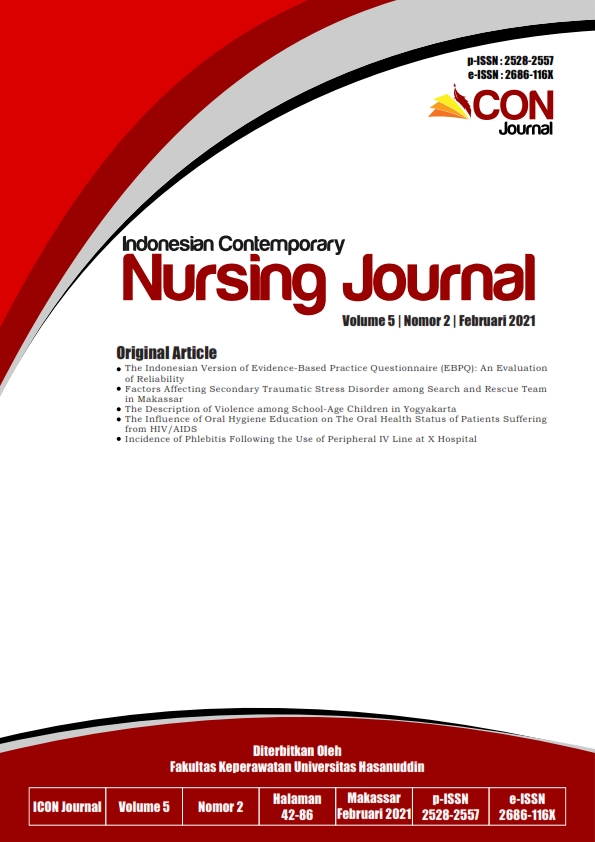Perspective Review: The Influence of Gait Efficacy on Improving Physical Activity in Community-Dwelling Older Adults
DOI:
https://doi.org/10.20956/icon.v8i1.28183Keywords:
Gait Efficacy, Older Adults, Perspective Review, Physical ActivityAbstract
Aging appears to be associated with a rise in the prevalence of inactivity. The Covid-19 pandemic was also reported associated with physical functioning and fall outcomes, with the greatest effect on individuals with reduced physical activity and social. Therefore, the elderly as the most populous group vulnerable need serious attention. Gait efficacy is defined as an individual’s perception of their level of confidence in order to perform safe walking tasks. Increasing older adults' gait-related self-efficacy is potentially necessary in order to promote self-regulation of physical activity and initiate the development of good physical activity habits as early prevention of disuse syndrome or inactivity in older adults.
References
Bandura, A. (2002). Self-Efficacy in Changing Societies. Cambridge University Press 1995.
Bazzucchi, I., Marchetti, M., Rosponi, A., Fattorini, L., Castellano, V., Sbriccoli, P., & Felici, F. (2005). Differences in the force/endurance relationship between young and older men. European Journal of Applied Physiology, 93(4), 390–397. https://doi.org/10.1007/s00421-004-1277-0
Halter, J. B., Ouslander, J. G., Studenski, S., Asthana, S., Supiano, M. A., & Ritchie, C. (2017). Hazzard’s Geriatric Medicine and Gerontology (W. R. Hazzard & N. R. Woolard, Eds.; Seventh Edition). McGraw-Hill Education.
Hoffman, G. J., Malani, P. N., Solway, E., Kirch, M., Singer, D. C., & Kullgren, J. T. (2022). Changes in activity levels, physical functioning, and fall risk during the COVID-19 pandemic. Journal of the American Geriatrics Society, 70(1), 49–59. https://doi.org/10.1111/jgs.17477
Mcauley, E., Konopack, J. F., Morris, K. S., Motl, R. W., Hu, L., Doerksen, S. E., & Rosengren, K. (2006). Physical activity and functional limitations in older women: influence of self-efficacy. The journals of gerontology. Series B, Psychological sciences and social sciences, 61(5), P270–P277. https://doi.org/10.1093/geronb/61.5.p270
Newell, A. M., Vanswearingen, J. M., Hile, E., & Brach, J. S. (2012). The modified gait efficacy scale: Establishing the psychometric properties in older adults. Physical Therapy, 92(2), 318–328. https://doi.org/10.2522/ptj.20110053
Okura, K., Shibata, K., Suda, T., Iwakura, M., Wakasa, M., Kimura, Y., & Okada, K. (2021). Gait-related Self-efficacy is Low in Older Adults with Knee Osteoarthritis: A Preliminary Study. Physical therapy research, 25(1), 31–34. https://doi.org/10.1298/ptr.E10128
Özden, F., Özkeskin, M., & Şahin, S. (2022). Cross-cultural adaptation, reliability and validity of the Turkish version of the modified Gait Efficacy Scale in community-dwelling older adults. Physiotherapy theory and practice, 1–8. Advance online publication. https://doi.org/10.1080/09593985.2022.2108530
Weijer, R. H. A., Hoozemans, M. J. M., van Dieën, J. H., & Pijnappels, M. (2022). Construct validity and reliability of the modified gait efficacy scale for older adults. Disability and rehabilitation, 44(11), 2464–2469. https://doi.org/10.1080/09638288.2020.1840638
Williamson, E., Sanchez Santos, M. T., Morris, A., Garrett, A., Conway, O., Boniface, G., Fairbank, J., & Lamb, S. E. (2021). The prevalence of back and leg pain and the cross-sectional association with adverse health outcomes in community dwelling older adults in england. Spine, 46(1), 54–61. https://doi.org/10.1097/BRS.0000000000003719
Downloads
Published
How to Cite
Issue
Section
License
Authors who publish with this journal agree to the following terms:Authors retain copyright and grant the journal right of first publication with the work simultaneously licensed under a Creative Commons Attribution License that allows others to share the work with an acknowledgement of the work's authorship and initial publication in this journal.
Authors are able to enter into separate, additional contractual arrangements for the non-exclusive distribution of the journal's published version of the work (e.g., post it to an institutional repository or publish it in a book), with an acknowledgement of its initial publication in this journal.
Authors are permitted and encouraged to post their work online (e.g., in institutional repositories or on their website) prior to and during the submission process, as it can lead to productive exchanges, as well as earlier and greater citation of published work (See The Effect of Open Access).


